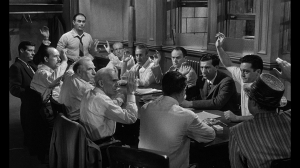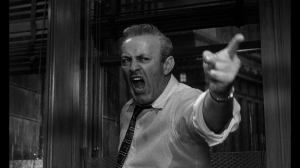The Demonstration of a Democratic, Just Society and an Exceptional Film
12 Angry Men (1957) opens in a New York courtroom at the conclusion of a murder trial. The judge instructs the jury that returning a guilty verdict will lead to the automatic death sentence of the defendant. With the exception of a few minutes at the beginning and end, the entire film takes place within a sixteen by twenty-four foot jury room. No names are given to any of the jurors; they are referred to only by juror number. This is symbolic of how the twelve jurors are strangers and are likely to remain strangers after a verdict is reached. These twelve strangers will decide upon the life and death of another human being, an eighteen-year-old Hispanic boy accused of murdering his father. For all intents and purposes, they are the law. The film’s tagline says it best: “Life is in their hands, death is on their minds.” From the start, it does not look good for the young defendant. One of the jurors even remarks how he wants to get out early because he has baseball tickets. The jurors take a customary opening vote and it is revealed that only juror #8 (Henry Fonda) believes the boy is not guilty. In voting not guilty, juror #8 says, “Well, there were eleven votes for guilty. It’s not easy to raise my hand and send a boy off to die without talking about it first.”

Juror 8 on the initial vote: “Well, there were eleven votes for guilty. It’s not easy to raise my hand and send a boy off to die without talking about it first.”
The film invites you to be a fly on the wall as this group of twelve men, with twelve different backgrounds and personalities, deliberate what appears to be an open and shut case of murder. The plot develops and builds tremendous momentum as one piece of evidence after another is called into serious doubt. The juror’s one by one begin to switch their votes to not guilty. There is a great scene towards the end where the camera pans around the table and focuses just on the juror’s hands as they vote and you can feel the uncertainty in juror #12 as he changes his vote to not guilty. If you pay close attention you will notice that the beginning of the film makes use of high angle shots using cameras with wide-angle lenses that are positioned above eyelevel. This is meant to give a sense of space in the jury room. As the film progresses, the shooting angles drop below eyelevel and many close-ups are used with telephoto lenses. This is meant to impart the growing sense of claustrophobia the jurors are feeling being cooped up in the tiny jury room.
Henry Fonda plays juror #8 whose quiet authority leads you to instinctually believe everything. Lee J. Cobb (juror #3), on the other hand, plays Fonda’s antithesis: rash, tempered, and excitable. Cobb’s performance is a marvel, one moment screaming at the top of his lungs, the next slumped back in his chair. Reginald Rose, whose TV play the film is based on, does an astonishing job developing each juror over the course of the film’s brisk ninety-five minute runtime. We get to know each juror and can understand the source of their attitudes towards the case.
The film was released back 1957, prior to the Civil Rights movement. However, outside obvious differences in composition, the way the jury deliberates this case is similar to juries today. Jury members naturally apply their personal prejudices to the case, typically irrelevant of facts and reason. Juror #10 (Ed Bagley) is consumed by personal prejudice in that he sees value in riding the streets of the troubled defendant. Juror #3 is impermeable to reason because he associates his own emotional pain caused by his falling-out with his son to the teenage boy who is on trial. Juror #3 is the last of the jurors to yield and switch his vote to not guilty. Just before breaking down he says, “Rotten kids, you work your life out… .” And although his actions throughout the film warrant little sympathy, you actually feel for him. The 11-1 vote for guilty at the film’s beginning, is now a unanimous 12-0 vote for not guilty.
 Juror #3, the self-appointed executioner: “What’s the matter with you guys? You all know he’s guilty. He’s got to burn. You’re letting him slip through our fingers.”
Juror #3, the self-appointed executioner: “What’s the matter with you guys? You all know he’s guilty. He’s got to burn. You’re letting him slip through our fingers.”
12 Angry Men is a film that I must watch at least once a year. It is a film that stirs your conscience. It makes you question whether our jury system is the best way to decide the liberty of another human being. After watching it I often think about what would have happed to this eighteen-year-old boy without someone like juror #8. Then I also think “what if he really did kill his father?” The film takes great effort to make you appreciate the importance of the concept of “beyond a reasonable doubt.” Midway through the film, juror #8 states, “We may be trying to let a guilty man go free, I don’t know. Nobody really can. But we have a reasonable doubt, and that’s something that’s very valuable in our system. No jury can declare a man guilty unless it’s sure.”
Shockingly, the film failed to make a profit and Fonda never received his deferred salary. Fonda, who was also a producer of the film, handpicked Sidney Lumet to direct. 12 Angry Men was the first film directed by Lumet although you would never know it; he would later go on to direct such greats as Dog Day Afternoon, Network and The Verdict. Fonda disliked watching himself on film and refused to watch the entire film in the projection room after editing was completed. But, before he walked out he said to director Sidney Lumet, “Sidney, it’s magnificent.” I could not agree more. If you have not seen 12 Angry Men, see it now. If you have, watch it again.
